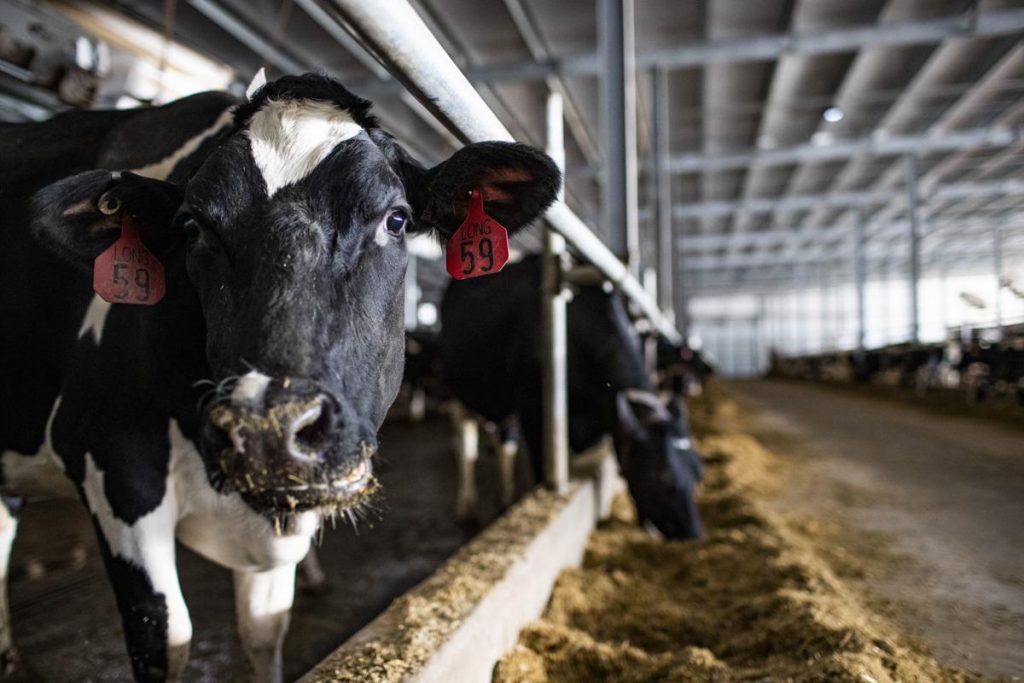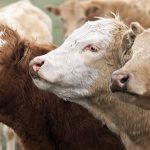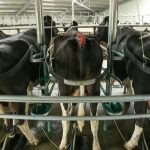
A typical day for Elkins might involve checking a computer report to get data on how production is going, troubleshooting a robot or making sure a device called a Juno does its job of pushing grain so it’s within reach of the 410 Holstein cows on this farm.
Those contented cows eagerly munch the grain and then dutifully head into a chute that leads to one of the eight bright red robots that do the work once done by hand.
Lasers guide mechanical nozzles that do the milking while the cow – outfitted with a unique ear tag and collar for identification – is weighed. The robot, after enticing Bossy with a food pellet, gathers information on the volume and temperature of the milk and the animal’s milking history.
Welcome to the brave new world of dairy farming, one in which depressed milk prices and a depressing scarcity of farm labor have made such automation almost as necessary as calcium in your diet.
“The biggest thing with these robots is the labor savings,” said Elkins, a 37-year-old who runs Knob View Dairy and the nearby Elkins Dairy with his father, Tim Elkins, and brother Chad Elkins. “We’re milking 600 or so cows at the other dairy, and it takes six or seven people to do the milking. That labor is getting harder and harder to find.”
Despite that need to save on labor costs, the Elkins family didn’t jump into the world of high-tech farming overnight. They ruminated for months over how best to handle this herd of ruminants.
“We probably thought about it for a couple of years,” Bradley Elkins said. “We visited some dairies that already had robots.”
Watching many of their fellow dairymen get out of the business as milk consumption and bulk milk prices both headed south, the Elkins family members pondered if there was a future in the business.
Such thoughts are understandable when you look at the numbers. U.S. milk farm prices, which floated above $25 per 100 pounds as recently as 2014, sunk down to the $15 range last year.
With U.S. Department of Agriculture statistics showing that Americans, on average, are drinking 37 percent less milk today than they did in 1970, that market price isn’t likely to rebound.
Small wonder that the number of Kentucky dairy farmers has plummeted from 2,000 to around 600 over the past 20 years.
Rather than join the ranks of ex-dairymen, Bradley Elkins explained that he and his family decided on the bold survival strategy of investing in eight Lely Astronaut robots listed on the website of the Netherlands-based company at a price tag of about $200,000 apiece.
The Lely machines started milking in June, making Knob View the biggest robotic dairy operation in the state.
“We’re all in,” Bradley Elkins said. “There’s no turning back now.”
In fact, the Knob View dairy barn was built to accommodate eight more robots, although Elkins said any expansion will depend on milk prices.
For now, he’s pleased with the results.
“It was an adjustment for the cows and for us,” he said. “But the cows are getting used to it, and they will typically give more milk in these systems.”
Elkins explained that cows are normally milked twice a day on traditional dairy farms. In a robotic operation, he said: “Each station can handle 60 cows per day and milk them three times a day on average.”
Knob View’s cows are producing 33,000 pounds (nearly 4,000 gallons) of milk per day, and Elkins believes the “cow comfort” features of the robotic operation can potentially help that number go higher.
As a result of increased production and lower labor costs, Elkins reasons that the robots that have a useful life of 15 years will pay for themselves in 10 years.
Another local dairy farmer, Carl Chaney, can vouch for the efficiency of the Lely robot. The dairyman and owner of the Chaney’s Dairy Barn restaurant and ice cream shop converted his 60-cow operation to the robot in 2016 and doesn’t regret it.
“We’ve been extremely happy with it,” Chaney said. “We had milked in the old barn from 1962 through 2016 twice a day, every day. It got to where we were always working around the schedule of those who were milking for us. It was very difficult. Dairy help is very hard to find.”
So Chaney eliminated his labor costs and also made his dairy more efficient by investing in a robot bought from Lely dealer Dairy Express Services in Columbia.
“You usually expect a 15 percent increase in production when you go from a standard operation to the robot,” Chaney said. “That’s what we based our budget on. But we’ve been getting about a 25 percent increase in production.
“The robot milks 24 hours a day, and the cows are able to go in at any time. We had figured the robot would pay for itself in a little over 10 years, but now we’re figuring about eight years.”
Josh Kemp, co-owner of Dairy Express Services, said the trend toward automation is here to stay as dairy farms look for efficiency.
“The market is definitely moving in that direction,” he said, adding that Lely continues to produce newer and better versions of the robot milkers. “The lack of a labor force is the No. 1 factor.”
Elkins, while saying he never dreamed just a few years ago that he would be milking with robots, now embraces the trend.
“It’s amazing how fast technology has taken over,” he said. “In another 50 years, there’s no telling what this business will look like.”























